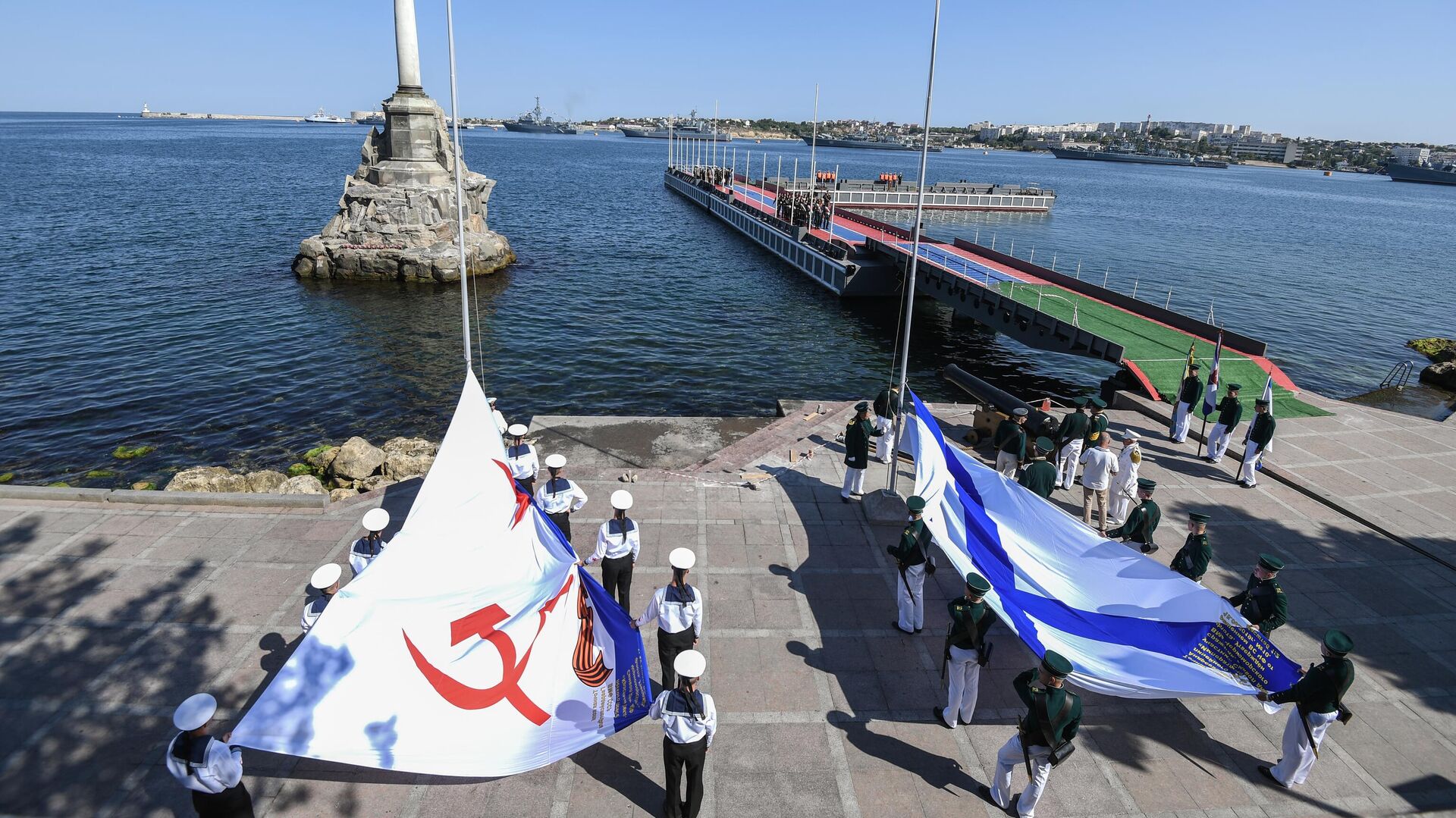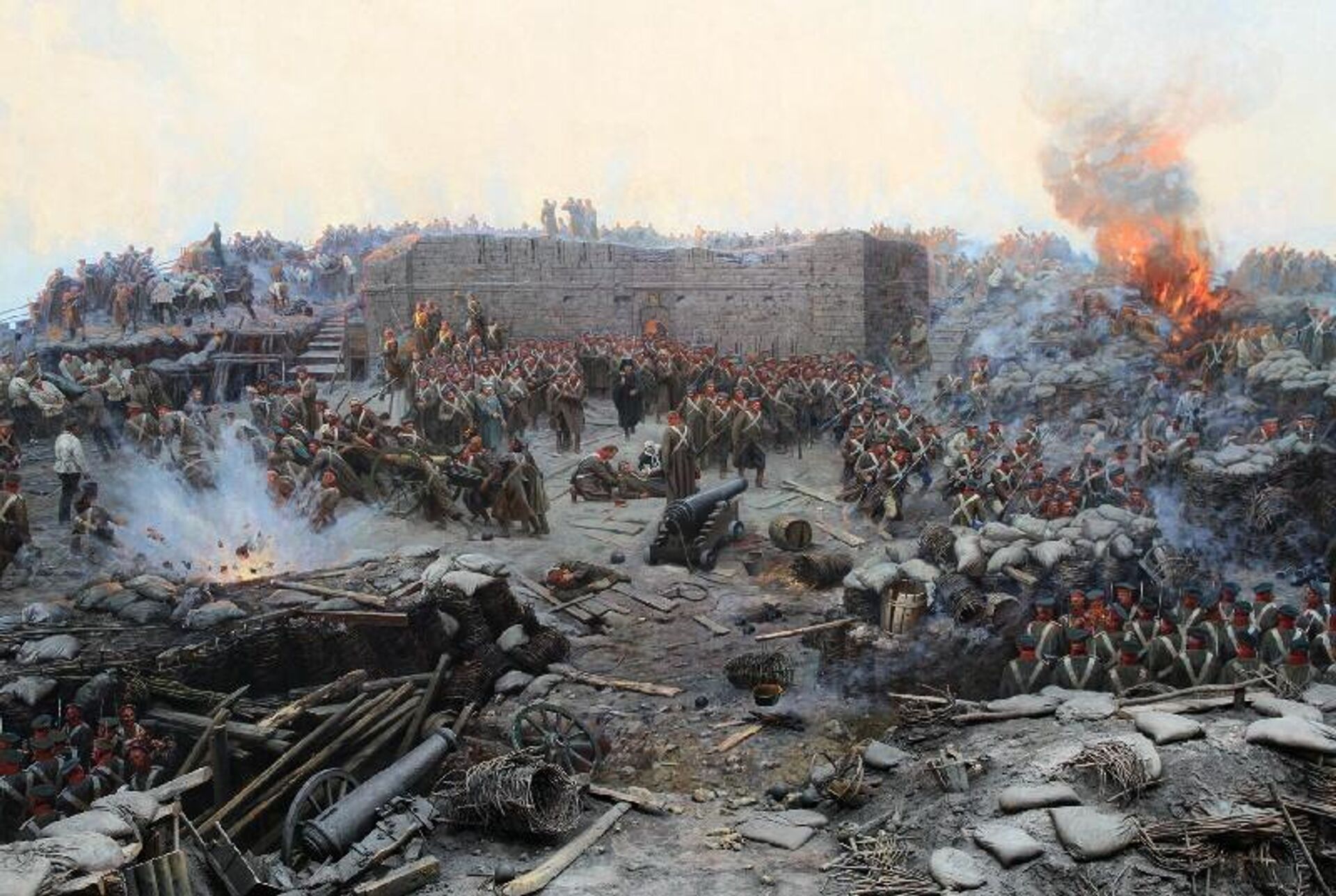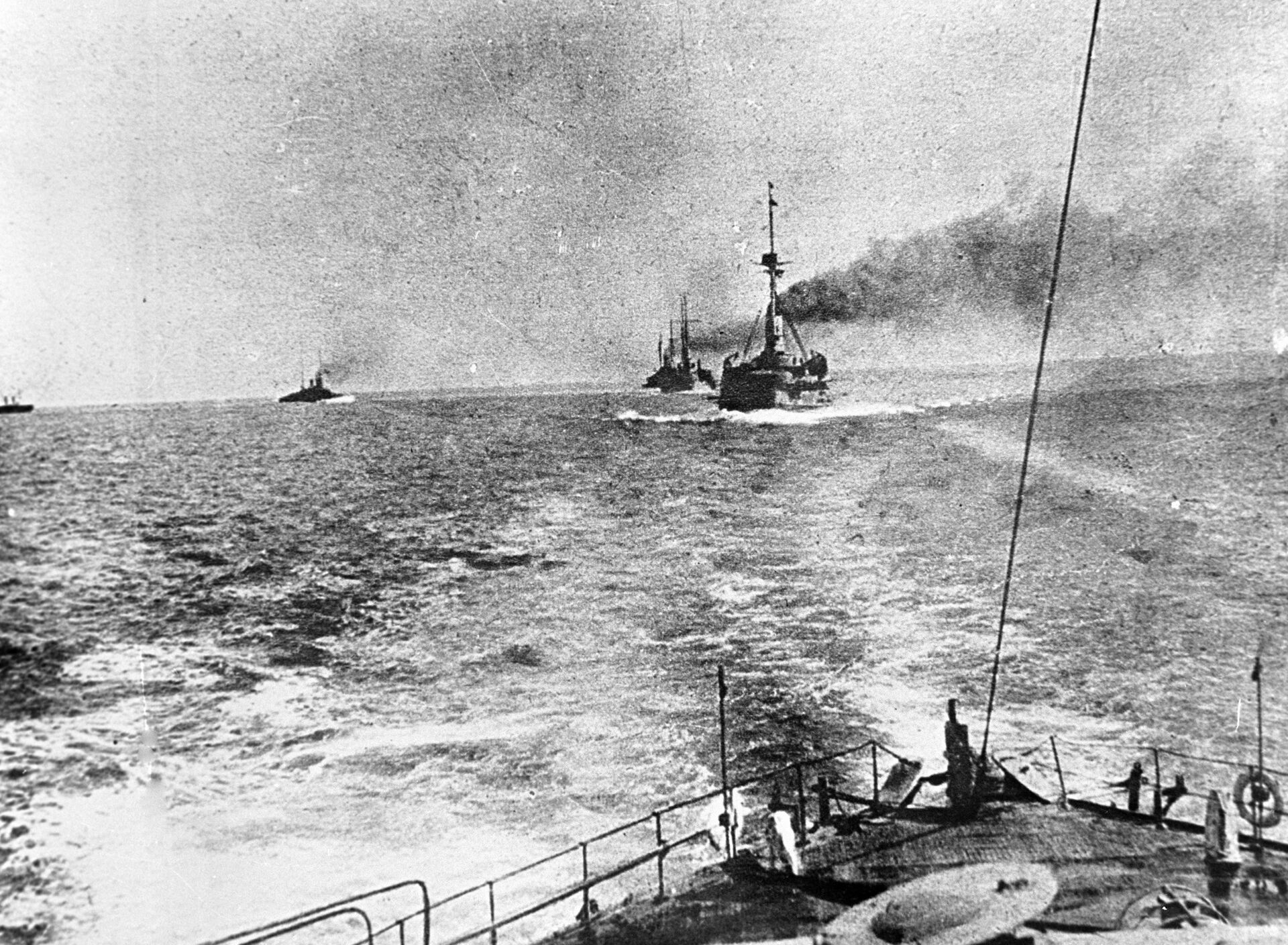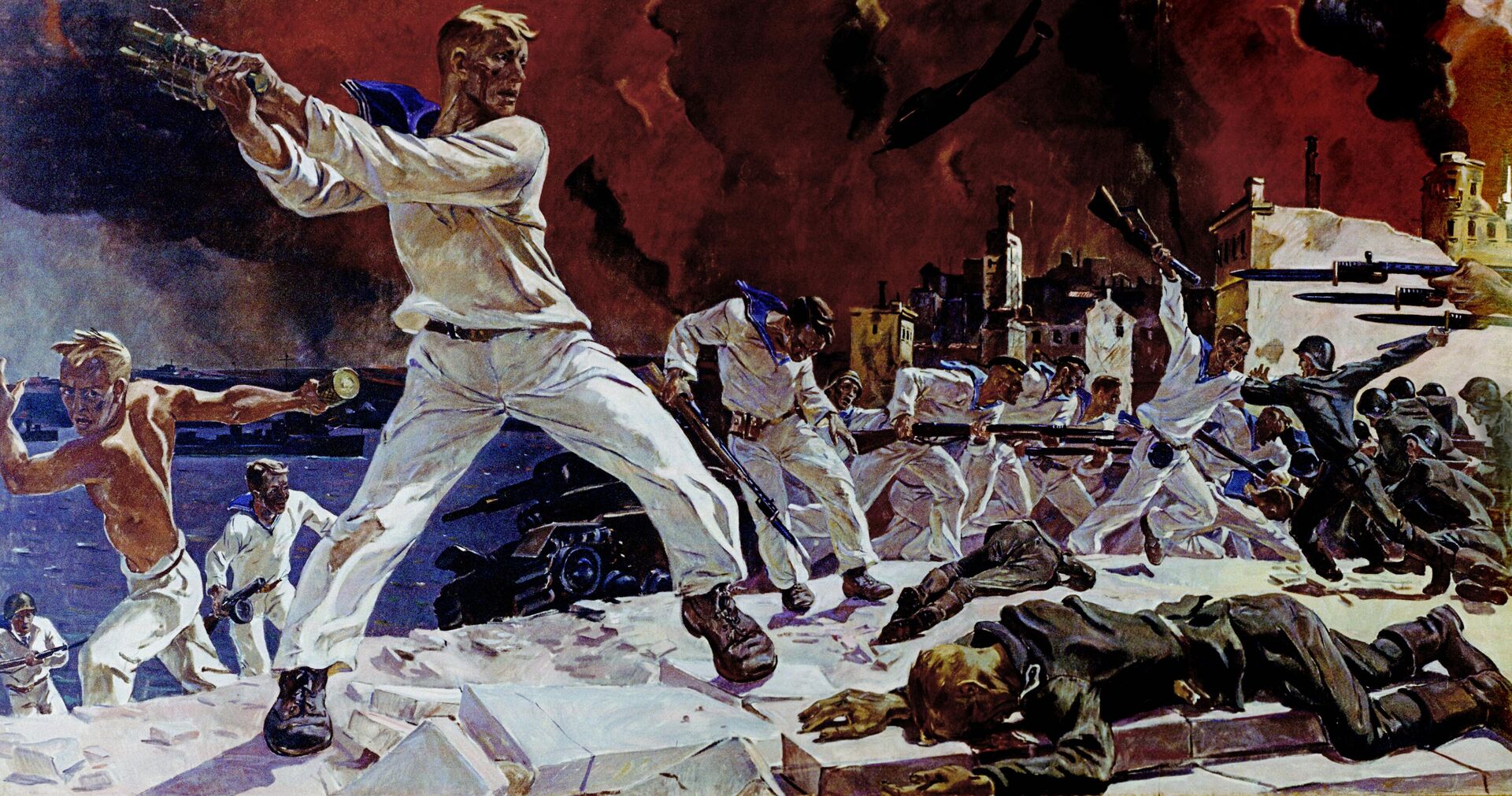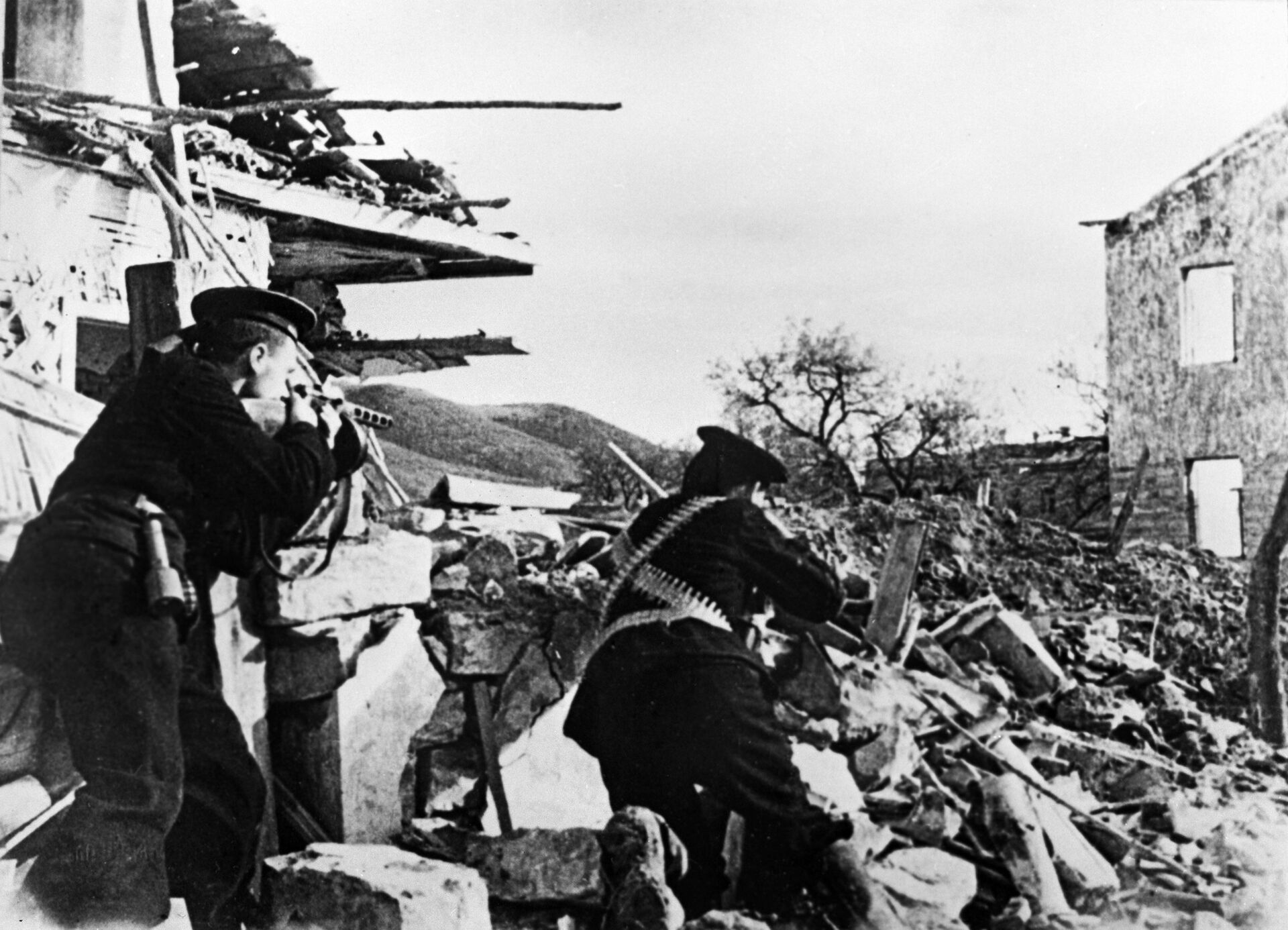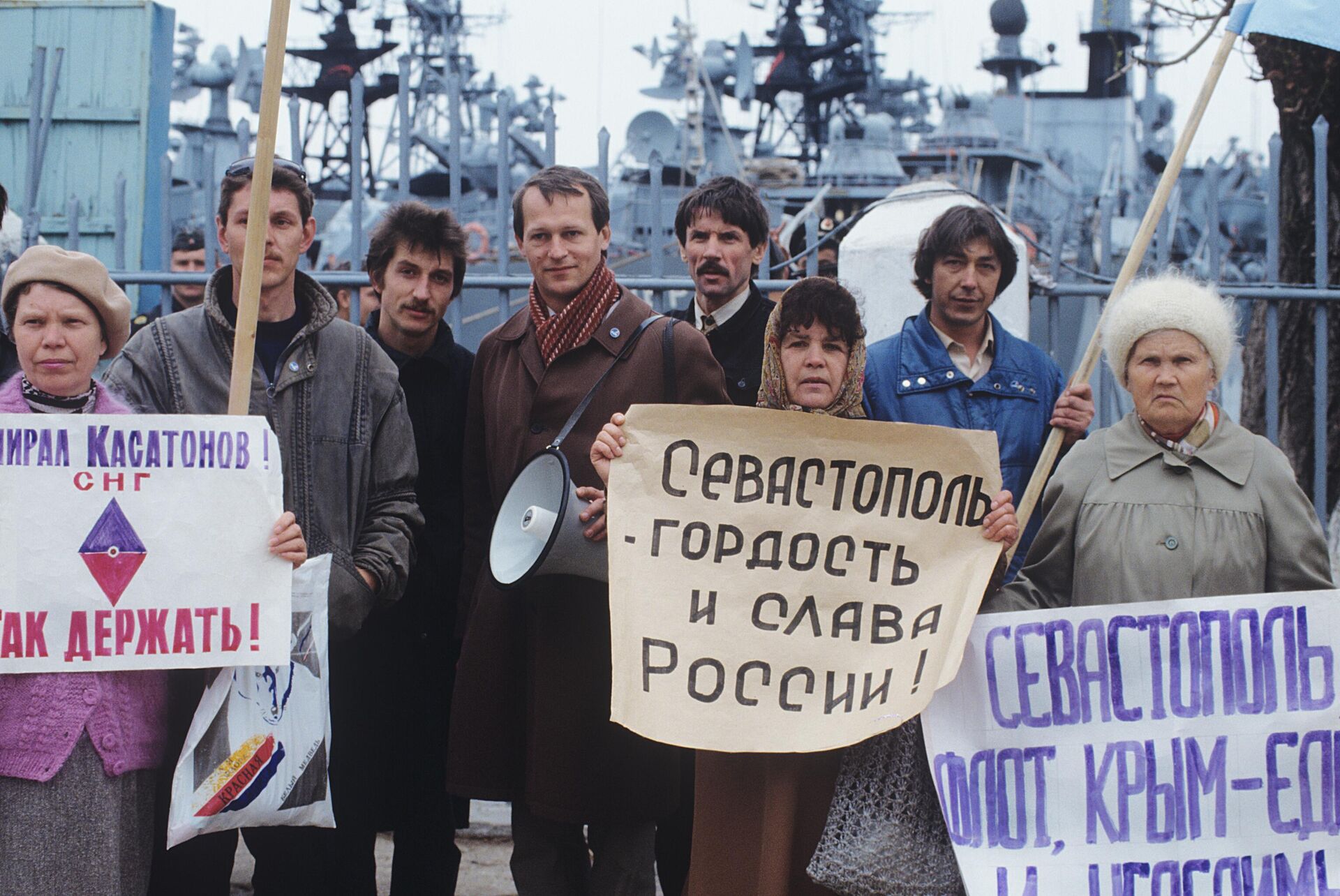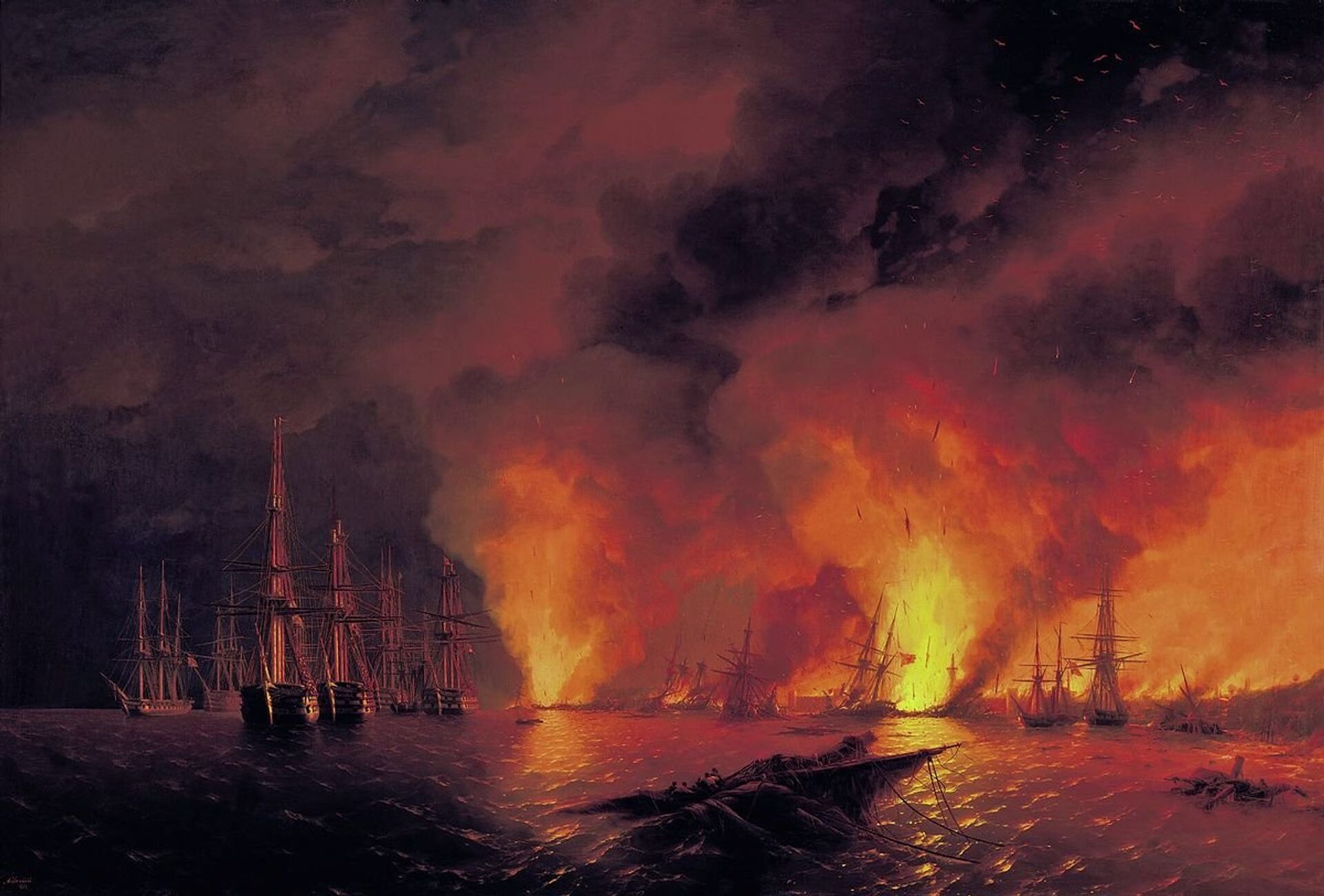https://sputnikglobe.com/20230513/black-sea-fleet-240-years-in-defense-of-russias-southern-frontiers-1110318775.html
Black Sea Fleet: 240 Years in Defense of Russia's Southern Frontiers
Black Sea Fleet: 240 Years in Defense of Russia's Southern Frontiers
Sputnik International
May 13 marks the 240th anniversary of the creation of the Russian Black Sea Fleet. Through its history, it has fallen to the sailors and officers of the fleet... 13.05.2023, Sputnik International
2023-05-13T17:06+0000
2023-05-13T17:06+0000
2023-05-13T17:06+0000
military
russia
sevastopol
crimea
imperial russian navy
russian black sea fleet
nazi
buyan-m
cargo ship
navy
https://cdn1.img.sputnikglobe.com/img/07e7/05/0d/1110319959_0:321:3072:2048_1920x0_80_0_0_b333a16d6d7717d69c04a73c6d440d6b.jpg
On this day in 1783, the Imperial Russian Navy’s Azov Flotilla was dissolved and its 11 ships assigned to the newly created Black Sea Fleet.Moored in the then-sparsely populated Ahtiar Bay in southwestern Crimea, the fleet was formed to protect the peninsula following its peaceful absorption into the Russian Empire in April of 1783, nine years after the end of Ottoman control over Crimea in the wake of the Russo-Turkish War of 1768-1774.Veteran naval officer Fedot Klokachev was appointed as the first commander of the new fleet, and began the construction of the Black Sea Fleet's future home - the city of Sevastopol, in July of 1783. Ahtiar Bay was later bestowed the name Sevastopol Bay.In the years that followed, the Black Sea Fleet was strengthened with new warships, while Sevastopol witnessed the construction of major fortifications and port infrastructure befitting of a major new naval force. By August 1785, the Black Sea Fleet consisted of over 13,500 sailors and officers, and had 12 battleships, 20 frigates, and about a dozen transports and multipurpose boats at its disposal - nearly quadrupling in size from its initial strength.Crimean WarThe Black Sea Fleet and the defenders of Sevastopol would spend the next hundred years protecting the Black Sea from Ottoman and European geopolitical and military intrigues, including during the Russo-Turkish War of 1787-1792, the 1821-1829 Greek War of Independence (in which Russia supported Athens), and the Crimean War of 1853-1856. The latter conflict saw Russia face off alone against a coalition of Ottoman, British, French and Sardinian forces, plus German, Swiss, Polish and Italian legions.The 1854-1855 Siege of Sevastopol saw the coalition invading Crimea and marching on the Black Sea Fleet’s home base, besieging it, with a garrison of 48,500 Russian defenders facing off against the combined strength of over 175,000 enemy troops. After 11 months of siege, Russian troops were finally forced to abandon the city, with Russia forced to sue for peace, and temporarily losing the right to base warships in Sevastopol (Russia would denounce these provisions in 1870, and the restrictions were scrapped with the signing of the London Convention of March 1871).The British and French empires were equally drained by the Crimean War, with the conflict proving highly unpopular in their home countries – perhaps best exemplified by Alfred, Lord Tennyson’s famous narrative poem ‘The Charge of the Light Brigade’ about the charge to their pointless death of scores of elite British troops on horseback against Russian defensive emplacements.Russia would gradually rebuild its Black Sea naval power toward the late 19th century.First World War Victories and Revolutionary ChaosIn the First World War, the Black Sea Fleet, now armed with modern battleships, destroyers, dreadnaughts and submarines, won the biggest victories that the Russian Empire managed to enjoy during the conflict –mining the Bosporus, providing support for the Romanian and Caucasus fronts, and destroying dozens of Ottoman warships.The Black Sea Fleet dissolved in the chaos following the twin revolutions of March and November of 1917, with Imperial German forces and a German puppet Ukrainian national government temporarily occupying Crimea in 1918, during which time over 130 ships were seized and taken abroad to countries including the Ottoman Empire. The Bolsheviks scuttled what was left of the fleet at Novorossiysk to prevent its capture. The Black Sea Fleet lay in ruins through most of the Russian Civil War, with Crimea and coastal territories surrounding it occupied by French and Greek forces. The intervention lasted until April 1919, when the occupiers were forced to evacuate.Rise of the Red NavyThe Black Sea Fleet began its reconstruction in 1921, starting with the restoration and upgrade of what remained of the Imperial Navy’s warships. Between the late 1920s and the late 1930s, over 500 vessels were added to the fleet thanks to industrialization and rearmament campaigns.The fleet met the beginning of the Great Patriotic War in June 1941 with 64,000 sailors and officers, one battleship, 5 cruisers, 3 flotilla leaders, 16 destroyers, 47 submarines and scores of smaller gunboats, patrol ships torpedo boats, minesweepers, patrol and anti-submarine boats. Sevastopol was turned into a fortress of modern coastal defenses, including elaborate fortifications and dozens of 305, 203, 152, 130, 120, 102, 100, and 45 mm coastal guns and machine guns, as well as 76 and 37 mm anti-aircraft guns.During the war, the Fleet was tasked with holding off the advancing Germans and their Bulgarian and Romanian allies, and watching carefully for a possible Turkish entry into the war on the Axis side.German and Romanian forces began an operation to capture Sevastopol in October 1941, with the city surrounded on all sides as Axis troops advanced through Crimea. The siege of Sevastopol continued for nine months until the city's fall in July 1942, and saw Soviet defenders face off against numerically superior German and Romanian troops with naval support from Italy. Over 200,400 Soviet troops were killed, injured or taken prisoner (many of them later dying in Nazi POW camps), with Soviet estimates on the number of enemy dead and wounded amounting to 300,000 men. Efforts to evacuate the remainder of the city’s defenders by sea were thwarted by Axis naval and air power, as were efforts to resupply them.The siege of Sevastopol tied up hundreds of thousands of Axis troops, and ultimately helped to delay and weaken Nazi offensives in the Caucasus during the summer of 1942 – culminating in the Battle of Stalingrad and the turning point in the war in Europe in the Allies’ favor.Sevastopol was occupied between July 1942 until May of 1944, when it was liberated during the Crimean Offensive Operation. Soviet naval aviation destroyed scores of German and Romanian cargo ships, tankers, tugs and motorboats as Nazi forces attempted to evacuate by sea.During the war, the Black Sea Fleet mounted over a dozen amphibious assaults, including the Kerch-Feodosia operation of 1941-1942, and the Kerch-Eltigen Operation of 1943-1944. The daring and determination of the fleet’s naval infantry in both offensive and defensive operations led the Germans to nickname them ‘Black Death’ due to the distinctive black color of their uniforms.After the end of WWII, Sevastopol, Crimea and the Black Sea Fleet would enjoy relative peace and tranquility over most of the remainder of the 20th century.In 1988 at the twilight of the Cold War, the US Navy’s USS Yorktown cruiser and the USS Caron destroyer tried to sail through Soviet territorial waters off Crimea under the guise of “rights and freedoms of navigation” in the Black Sea, prompting the Soviet warships Bezzavetny and the SKR-6 frigates to bump up against and literally push the intruders out of the area. The incident was filmed by sailors onboard the US ships, demonstrating the panic that ensued once the Americans realized what the smaller Soviet vessels shadowing the US warships were doing.Hard Times in the 1990sThe collapse of the USSR in 1991 raised hard questions about the Black Sea Fleet’s status, with Russian President Boris Yeltsin refusing to contemplate apparent willingness by Kiev to return Crimea and Sevastopol to Russia’s jurisdiction (the peninsula had been transferred to the Ukrainian SSR from the Russian SFSR by Soviet leader Nikita Khrushchev through the course of interparty-elite political maneuvers in 1954). In 1991, the fleet of 100,000 sailors and officers and 835 warships suddenly found itself facing an uncertain future.Ultimately, naval assets would divided between the new states and an agreement reached for Sevastopol to remain the headquarters of the Russian Black Sea Fleet. Russia would lease the Sevastopol Naval Base and other naval facilities in Crimea from Ukraine, with Kiev receiving cash payments and certain bonuses like discounts on energy worth tens of billions of dollars. In 1997, an agreement was reached under which Russia received 338 ships and over 100 aircraft of the Black Sea Fleet, with the Ukrainian side getting 67 ships and 90 combat aircraft.The lease agreement lost its relevance in March 2014 when, a month after a Western-backed coup in Kiev ousted the country’s democratically-elected president, Crimean authorities held a snap referendum on the peninsula’s status, with the overwhelming majority of Crimea’s residents voting to break off from Ukraine and rejoin Russia.Back In Home HarborsCrimea’s return to Russia led to immediate major investments into the Black Sea Fleet’s capabilities –with the fleet fitted out with new ships and aircraft, including Buyan-M missile ships, Project 636.3 attack subs, and the new Admiral Grigorovich-class of frigates, including its lead ship, the Admiral Grigorovich, plus the Admiral Essen and the Admiral Makarov, commissioned in 2016 and 2017, respectively. Together with the Pytlivyy and Ladny frigates, the warships make up the 30th Surface Ship Division.Today, the Black Sea Fleet also has six large landing ships of the Project 1171 and Project 775 classes, the 4th Separate Submarine Brigade with its nine attack subs, the 41st Missile Boat Brigade and its Buyan-M, Sivuch and Molniya-1 missile boats (8 total, two more on the way), the 295thMissile Boat Battalion and its four vessels, and dozens of smaller anti-submarine warfare and minesweeping vessels, coastal patrol ships, ASW and coastal defense craft, firefighting, rescue ships, tugs, tankers and reconnaissance ships. Most of the fleet is based at Sevastopol and Novorossiysk.The Black Sea Fleet has been used extensively during the course of the ongoing Russia-NATO proxy war in Ukraine, with the fleet’s resources used in battles against Ukrainian forces for Zmeiny Island, as well as operations to destroy Ukraine’s naval forces and prevent them from leaving their home ports, and keeping NATO ships and reconnaissance assets from approaching too close to Crimea and the conflict zone.At least three major ships of the Black Sea Fleet have been lost in the course of the conflict, with the missile cruiser Moskva – the former flagship of the fleet, suffering critical damage in a munitions explosion in April 2022 and sinking while being towed back to port. A Russian large landing ship was lost in March 2022, and the Vasily Bekh tugboat was lost in June 2022 off Zmeiny Island.The Ukrainian Navy was forced to scuttle its flagship, the Hetman Sahaydachny, in March of 2022, and has lost dozens of patrol ships, river patrol boats, reconnaissance vessels, command and control vessels, minesweepers, tugs, and gunboats over the past 14 months. Some were sunk in Russian attacks, others scuttled, and others still captured by Russian forces (including multiple Gyurza-M gunboats, Zhuk-class patrol boats, Kalkan-class and UMS-1000-class patrol cutters, a Sorum-class sea-going tug, and up to 10 unmanned reconnaissance vessels).1783-2023: Some Things Remain Eternal
https://sputnikglobe.com/20150813/russia-ukraine-crimea-yeltsin-1025713518.html
https://sputnikglobe.com/20230513/what-battle-force-ships-does-russias-black-sea-fleet-have-1110312307.html
https://sputnikglobe.com/20220820/uav-attacks-russian-black-sea-headquarters-in-sevastopol-governor-says-1099790129.html
russia
sevastopol
crimea
Sputnik International
feedback@sputniknews.com
+74956456601
MIA „Rossiya Segodnya“
2023
News
en_EN
Sputnik International
feedback@sputniknews.com
+74956456601
MIA „Rossiya Segodnya“
Sputnik International
feedback@sputniknews.com
+74956456601
MIA „Rossiya Segodnya“
russia, sevastopol, crimea, imperial russian navy, russian black sea fleet, nazi, buyan-m, cargo ship, navy, warships, submarines
russia, sevastopol, crimea, imperial russian navy, russian black sea fleet, nazi, buyan-m, cargo ship, navy, warships, submarines
On this day in 1783, the Imperial Russian Navy’s Azov Flotilla was dissolved and its 11 ships assigned to the newly created Black Sea Fleet.
Moored in the then-sparsely populated Ahtiar Bay in southwestern Crimea, the fleet was formed to protect the peninsula following its peaceful absorption into the Russian Empire in April of 1783, nine years after the end of Ottoman control over Crimea in the wake of the Russo-Turkish War of 1768-1774.
Veteran naval officer Fedot Klokachev was
appointed as the first commander of the new fleet, and began the construction of the Black Sea Fleet's future home - the city of Sevastopol, in July of 1783. Ahtiar Bay was later bestowed the name Sevastopol Bay.
In the years that followed, the Black Sea Fleet was strengthened with new warships, while Sevastopol witnessed the construction of major fortifications and port infrastructure befitting of a major new naval force. By August 1785, the Black Sea Fleet consisted of over 13,500 sailors and officers, and had 12 battleships, 20 frigates, and about a dozen transports and multipurpose boats at its disposal - nearly quadrupling in size from its initial strength.
The Black Sea Fleet and the defenders of Sevastopol would spend the next hundred years protecting the Black Sea from Ottoman and European geopolitical and military intrigues, including during the Russo-Turkish War of 1787-1792, the 1821-1829 Greek War of Independence (in which Russia supported Athens), and the
Crimean War of 1853-1856. The latter conflict saw Russia face off alone against a coalition of Ottoman, British, French and Sardinian forces, plus German, Swiss, Polish and Italian legions.
The 1854-1855 Siege of Sevastopol saw the coalition invading Crimea and marching on the Black Sea Fleet’s home base, besieging it, with a garrison of 48,500 Russian defenders facing off against the combined strength of over 175,000 enemy troops. After 11 months of siege, Russian troops were finally forced to abandon the city, with Russia forced to sue for peace, and temporarily losing the right to base warships in Sevastopol (Russia would denounce these provisions in 1870, and the restrictions were scrapped with the signing of the London Convention of March 1871).
The British and French empires were equally drained by the Crimean War, with the conflict proving highly unpopular in their home countries – perhaps best exemplified by Alfred, Lord Tennyson’s famous narrative poem ‘The Charge of the Light Brigade’ about the charge to their pointless death of scores of elite British troops on horseback against Russian defensive emplacements.
Russia would gradually rebuild its Black Sea naval power toward the late 19th century.
First World War Victories and Revolutionary Chaos
In the First World War, the Black Sea Fleet, now armed with modern battleships, destroyers, dreadnaughts and submarines, won the biggest victories that the Russian Empire managed to enjoy during the conflict –mining the Bosporus, providing support for the Romanian and Caucasus fronts, and destroying dozens of Ottoman warships.
The Black Sea Fleet dissolved in the chaos following the twin revolutions of March and November of 1917, with Imperial German forces and a German puppet Ukrainian national government temporarily occupying Crimea in 1918, during which time over 130 ships were seized and taken abroad to countries including the Ottoman Empire. The Bolsheviks scuttled what was left of the fleet at Novorossiysk to prevent its capture. The Black Sea Fleet lay in ruins through most of the Russian Civil War, with Crimea and coastal territories surrounding it occupied by French and Greek forces. The intervention lasted until April 1919, when the occupiers were forced to evacuate.
The Black Sea Fleet began its reconstruction in 1921, starting with the restoration and upgrade of what remained of the Imperial Navy’s warships. Between the late 1920s and the late 1930s, over 500 vessels were added to the fleet thanks to industrialization and rearmament campaigns.
The fleet met the beginning of the Great Patriotic War in June 1941 with 64,000 sailors and officers, one battleship, 5 cruisers, 3 flotilla leaders, 16 destroyers, 47 submarines and scores of smaller gunboats, patrol ships torpedo boats, minesweepers, patrol and anti-submarine boats. Sevastopol was turned into a fortress of modern coastal defenses, including elaborate fortifications and dozens of 305, 203, 152, 130, 120, 102, 100, and 45 mm coastal guns and machine guns, as well as 76 and 37 mm anti-aircraft guns.
During the war, the Fleet was tasked with holding off the advancing Germans and their Bulgarian and Romanian allies, and watching carefully for a possible Turkish entry into the war on the Axis side.
German and Romanian forces began an operation to capture Sevastopol in October 1941, with the city surrounded on all sides as Axis troops advanced through Crimea. The siege of Sevastopol continued for nine months until the city's fall in July 1942, and saw Soviet defenders face off against numerically superior German and Romanian troops with naval support from Italy. Over 200,400 Soviet troops were killed, injured or taken prisoner (many of them later dying in Nazi POW camps), with Soviet estimates on the number of enemy dead and wounded amounting to 300,000 men. Efforts to evacuate the remainder of the city’s defenders by sea were thwarted by Axis naval and air power, as were efforts to resupply them.
The siege of Sevastopol tied up hundreds of thousands of Axis troops, and ultimately helped to delay and weaken Nazi offensives in the Caucasus during the summer of 1942 – culminating in the Battle of Stalingrad and the turning point in the war in Europe in the Allies’ favor.
Sevastopol was occupied between July 1942 until May of 1944, when it was liberated during the Crimean Offensive Operation. Soviet naval aviation destroyed scores of German and Romanian cargo ships, tankers, tugs and motorboats as Nazi forces attempted to evacuate by sea.
During the war, the Black Sea Fleet mounted over a dozen amphibious assaults, including the Kerch-Feodosia operation of 1941-1942, and the Kerch-Eltigen Operation of 1943-1944. The daring and determination of the fleet’s naval infantry in both offensive and defensive operations led the Germans to nickname them ‘Black Death’ due to the distinctive black color of their uniforms.
Over 835 enemy ships were sunk and 539 damaged overall during the war, with the Black Sea Fleet losing one cruiser, 3 flotilla leaders, 11 destroyers and 32 submarines, as well as 322 smaller vessels including minesweepers, patrol boats, ASW craft, torpedo boats, air defense boats and landing boats, for an overall loss ratio of over 2-1 in the Black Sea Fleet's favor.
After the end of WWII, Sevastopol, Crimea and the Black Sea Fleet would enjoy relative peace and tranquility over most of the remainder of the 20th century.
In 1988 at the twilight of the Cold War, the US Navy’s USS Yorktown cruiser and the USS Caron destroyer tried to sail through Soviet territorial waters off Crimea under the guise of “rights and freedoms of navigation” in the Black Sea, prompting the Soviet warships Bezzavetny and the SKR-6 frigates to bump up against and literally push the intruders out of the area. The incident was filmed by sailors onboard the US ships, demonstrating the panic that ensued once the Americans realized what the smaller Soviet vessels shadowing the US warships were doing.
The collapse of the USSR in 1991 raised hard questions about the Black Sea Fleet’s status, with Russian President Boris Yeltsin refusing to contemplate apparent willingness by Kiev to return Crimea and Sevastopol to Russia’s jurisdiction (the peninsula had been transferred to the Ukrainian SSR from the Russian SFSR by Soviet leader Nikita Khrushchev through the course of interparty-elite political maneuvers in 1954). In 1991, the fleet of 100,000 sailors and officers and 835 warships suddenly found itself facing an uncertain future.
Ultimately, naval assets would divided between the new states and an agreement reached for Sevastopol to remain the headquarters of the Russian Black Sea Fleet. Russia would lease the Sevastopol Naval Base and other naval facilities in Crimea from Ukraine, with Kiev receiving cash payments and certain bonuses like discounts on energy worth tens of billions of dollars. In 1997, an agreement was reached under which Russia received 338 ships and over 100 aircraft of the Black Sea Fleet, with the Ukrainian side getting 67 ships and 90 combat aircraft.
The lease agreement lost its relevance in March 2014 when, a month after a Western-backed coup in Kiev ousted the country’s democratically-elected president, Crimean authorities held a snap referendum on the peninsula’s status, with the overwhelming majority of Crimea’s residents voting to break off from Ukraine and rejoin Russia.
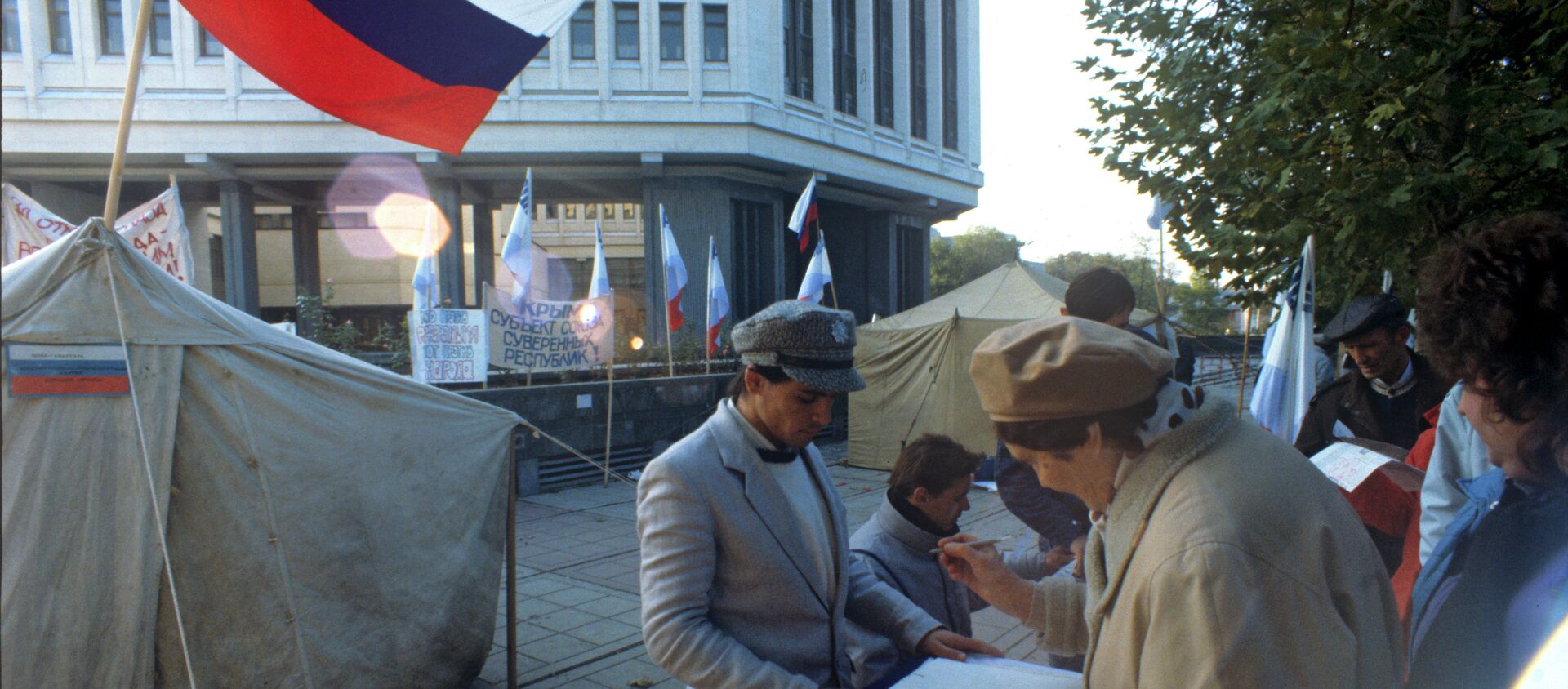
13 August 2015, 14:41 GMT
Crimea’s return to Russia led to immediate major investments into the Black Sea Fleet’s capabilities –with the fleet fitted out with new ships and aircraft,
including Buyan-M missile ships, Project 636.3 attack subs, and the new Admiral Grigorovich-class of frigates, including its lead ship, the Admiral Grigorovich, plus the Admiral Essen and the Admiral Makarov, commissioned in 2016 and 2017, respectively. Together with the Pytlivyy and Ladny frigates, the warships make up the 30th Surface Ship Division.
Today, the Black Sea Fleet also
has six large landing ships of the Project 1171 and Project 775 classes, the 4th Separate Submarine Brigade with its nine attack subs, the 41st Missile Boat Brigade and its Buyan-M, Sivuch and Molniya-1 missile boats (8 total, two more on the way), the 295thMissile Boat Battalion and its four vessels, and dozens of smaller anti-submarine warfare and minesweeping vessels, coastal patrol ships, ASW and coastal defense craft, firefighting, rescue ships, tugs, tankers and reconnaissance ships. Most of the fleet is based at Sevastopol and Novorossiysk.
The Black Sea Fleet has been used extensively during the course of the ongoing Russia-NATO proxy war in Ukraine, with the fleet’s resources used in battles against Ukrainian forces for Zmeiny Island, as well as operations to destroy Ukraine’s naval forces and prevent them from leaving their home ports, and keeping NATO ships and reconnaissance assets from approaching too close to Crimea and the conflict zone.
At least three major ships of the Black Sea Fleet have been lost in the course of the conflict, with the missile cruiser
Moskva – the former flagship of the fleet, suffering critical damage in a munitions explosion in April 2022 and sinking while being towed back to port. A Russian large landing ship was
lost in March 2022, and the Vasily Bekh tugboat was
lost in June 2022 off Zmeiny Island.
The Ukrainian Navy was forced to scuttle its flagship, the Hetman Sahaydachny, in March of 2022, and has lost
dozens of patrol ships, river patrol boats, reconnaissance vessels, command and control vessels, minesweepers, tugs, and gunboats over the past 14 months. Some were sunk in Russian attacks, others scuttled, and others still captured by Russian forces (including multiple Gyurza-M gunboats, Zhuk-class patrol boats, Kalkan-class and UMS-1000-class patrol cutters, a Sorum-class sea-going tug, and up to 10 unmanned reconnaissance vessels).
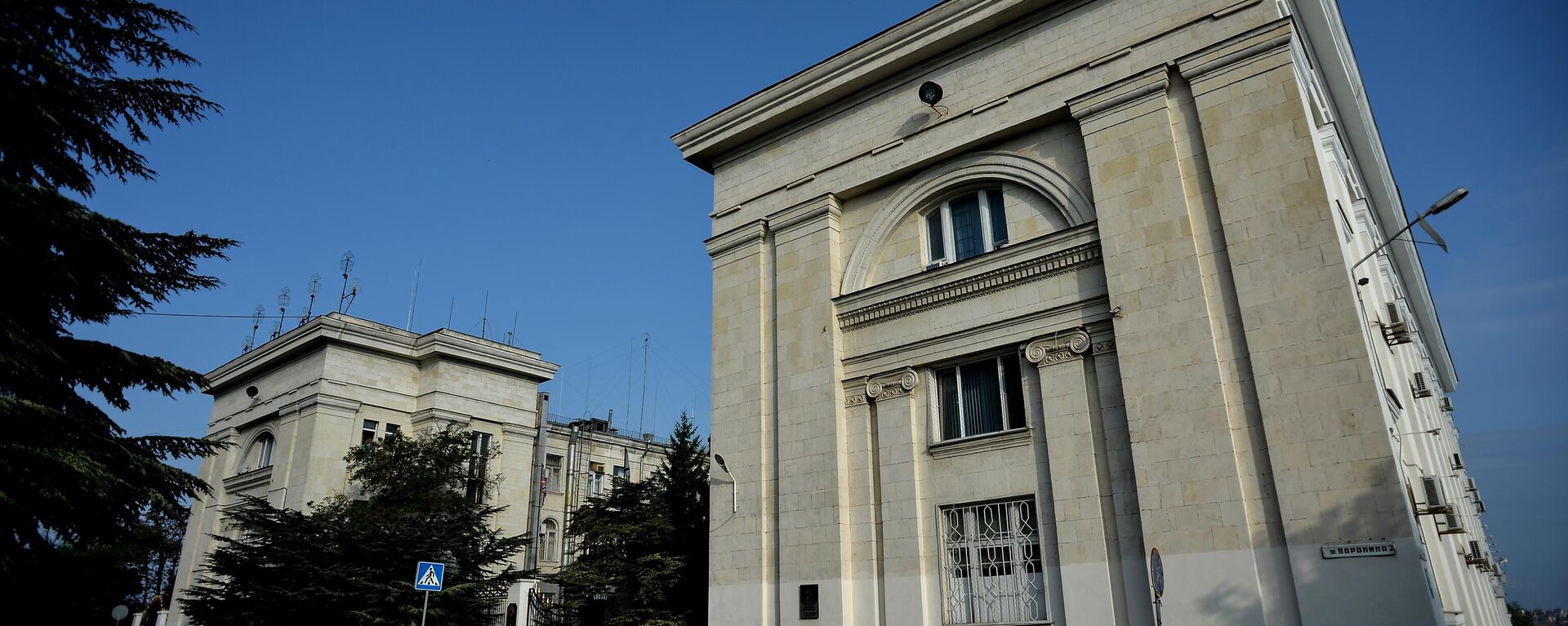
20 August 2022, 05:51 GMT
1783-2023: Some Things Remain Eternal
For 240 years, the Black Sea Fleet has been tasked with ensuring the security of Russia’s southern maritime borders and defending Russia's interests globally. Nearly two-and-a-half centuries after its creation, the conflict in Ukraine shows the continued strategic importance of the fleet, and the undisguised appetites of Russia’s adversaries to try to weaken and dismantle it and seize Crimea.
